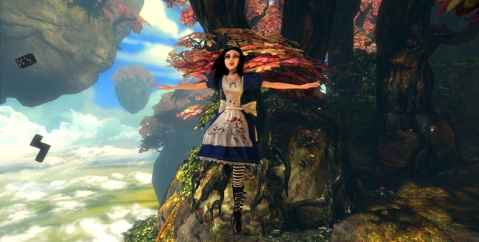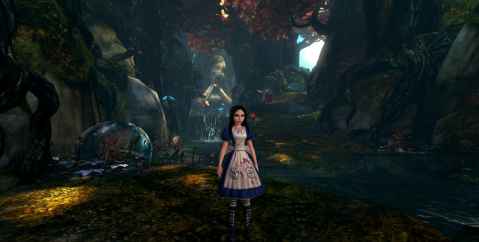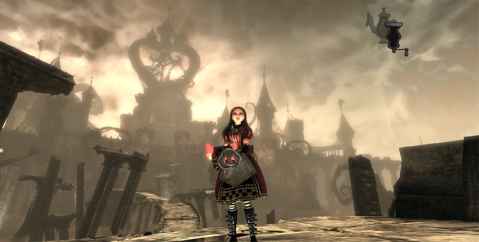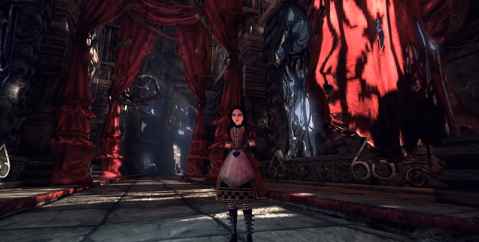Way back in 2000, a man named American McGee[a] created American McGee's Alice[b]. It was a re-imagining of the Alice in Wonderland stories in the form of a first person shooter / platformer. I bought it for the visuals and loved it. Alice: Madness Returns is the sequel, now powered by the Unreal 3 engine. On the whole, Alice is a great game that is brought down to "barely passable" by some very poor decisions by its creators.
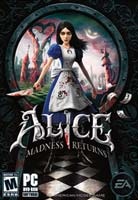
Alice: Madness Returns
Spicy Horse Games
EA, 2011
PC
A great game that is brought down to "barely passable" by some very poor decisions by its creators. A pleasure to look at, but a pain to play. (2/5)
Let's start with what makes the game great and truly unique: The world-building and the visuals. Just like it's predecessor, Alice simply isn't of this world:
There are a multitude of art styles in the game, all done very well. Unfortunately, watching pretty paint drying isn't less boring, pretty as it may be, and here is the problem with the game: Alice is a big pile of wonderful art assets that hasn't been properly edited or assembled.
Looking at the game it is obvious that it is intended to be story-driven. However, much of the story is pushed out into secret areas, so unless you go looking in every secret area, you will miss out on a major part of the game. In short, the storyline - the very backbone of the game - has been pushed to the periphery and hidden away. There are hundreds of secret areas and all are virtually identical: You "shrink" Alice, go through a keyhole and a tunnel, and end up in a small room. If you are lucky, there will be a "memory" - part of Alice's fragmented memories - in that room that helps tie the main storyline together. So to understand what is going on in the game, you have to spend literally hours running through the same little tunnel, back and forth. Those with an interest in video game history will perhaps find the concept of having to repeatedly descend into small spaces on the off chance of finding core game items familiar. They would be right. It was a core mechanic[1] of E.T. the Extra-Terrestrial, released in 1982 and often called the worst video game ever made
. The concept hasn't become better with the years.
If you choose to not bore yourself to death with the memories, you end up playing through a story that makes little sense, making the gameplay feel even more repetitive than it really is; and it is repetitive. Each mechanic is re-used so many times that by the end of it, it isn't just Alice that is mad. Let me illustrate with an example: In one part of the game, you must climb three peaks to reach a character. Before actually climbing the peak, you must prove your worth by solving a sliding block puzzle. Before actually solving the puzzle, you must find four blocks. Before finding each block, you may have to either do a timed jumping puzzle, fight some enemies, or a combination of those. So let's repeat that: Solve the puzzles, to get the blocks, to solve the sliding-block puzzles, to climb the peaks, to meet with the character. Grind? Grind-tastic! Alice is packed with such sequences, where you essentially re-play the same part over and over again, like some obsessive-compulsive lunatic.
Art is about communication, and only what ends up making an impression on the person receiving the artwork counts. If something isn't noticed, either because it is too small or brief, or because it is delivered among so much else that the observer's senses are dulled, it is useless. American calls his company Spicy Horse, and therefore a comparison with food is apt: Spice works to give food flavor, but unless varied the brain will "tune out" the sensation, no matter how pleasurable. Good chefs know this and vary the flavors in a three-course meal, all the time making sure to not "saturate" the person eating. Alice fails to do this. The game contains many brilliant and stunningly beautiful things, but they are repeated to such an extent that their brilliance is lost in the all-engulfing tedium.
I completed the game in 13 hours and 13 minutes. I think it could be cut to three to four hours without anything of value being lost. A real tight editing could probably bring it down to just under three hours. Very short and perhaps not what is considered a full-price game nowadays, but if games are to be considered art we must value each game for quality, not quantity. It is about what you create, not how many times you duplicate it.
The controls are of the made-for-console variety. Each weapon has a dedicated key and if you play this on a PC mouse/keyboard combo, your fingers will be forced to do acrobatics like they have never done before. Many events depend on you being able to pull off a sequence of keypresses with precise timing, making the plethora of keys an annoyance. The mouse controls are slow and also one of those made-for-console with an accelerated cursor. As you look around or aim the weapon, there is an initial slowness to the movement before the slew rate picks up. The result is that you won't be snapping away shots with a flick of the mouse. The aiming also suffers from severe parallax issues, where the enemy may be visible, the crosshair indicate that you will hit - and yet the shots end up blocked by scenery. All of this gives combat a slow repetitive pace. You end up using the "focus" system to lock on to enemies in order to have a hope of hitting them, instead of the frantic run-and-gun style I tend to enjoy. Here I ended up locking on and then constantly retreating while repeatedly bombarding the enemies with the tea-pot cannon. The focus system also has problems in that it won't let you switch lock to an enemy that isn't on the screen. You must un-focus, turn (there is the slow turn rate again), re-focus and iterate over the targets until you get the one you want. If that sounds like a flow-breaker, it is.
Analysis
All of this makes me sad. I really enjoyed the first Alice game, and found in it a constant sense of urgency that drove me on. None of that is here. I had been looking forward to the game and found it wanting. I'm still waiting for an official post-mortem, but I'd like to take a stab at why the game turned out as it did. What I intend to focus on is the development methodology of Spicy Horse:
The company's development process utilizes a "core team" methodology and 100% outsourced art asset production to conserve energy directed at the core competencies of game development.
My experience with outsourcing is that one must be very precise in what one orders. The people doing outsourced work are generally doing multiple projects for multiple clients, meaning that they don't really submerge themselves in one project. This can give the result of outsourced work a disjointed feel, as the people involved were never on the same page. This can be mitigated by only outsourcing some work - typically the simplest, or the work that can be defined so precisely that no deeper understanding of the project as a whole is needed to produce it.
If anything, this is the scar that I see running through Alice. Spicy Horse outsourced the art asset production, but ended up with a set of basic art assets and no good way to assemble them into a game of the size they had intended to create. Complex, one-off pieces couldn't be made by the outsourcing process, but basic pieces, or pieces based on an existing template could be produced with ease. That's why we see the same platforms, the same puzzles, repeated over and over again with some variations. For example, Alice has six dresses that you can switch between, each giving her slightly different abilities. A nice touch, but a typical work-from-template. It is also why the storyline ends up hidden away: A good story can't be built on repetition. The primary means of expression available to a FPS game designer is in the levels themselves, and the one-off level pieces required to tell a story well simply weren't available.
When outsourcing works, it works great. But we must also realize that some tasks require such a degree of synchronization between the team members and such a deep understanding of the product vision that only an in-house process, or outsourcing that is in-house in all but name, can deliver.
Finally, the obsessiveness with collection of memories and bottles and whatnot in the game reminds me of Psychonauts, another great game that was brought down a bit by being collection-heavy and somewhat repetitive. American, have you been playing with that Schafer[e] boy again? You shouldn't. He's not good for you.
